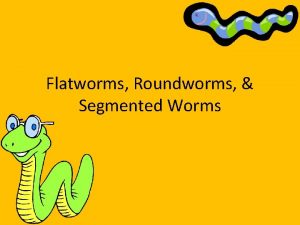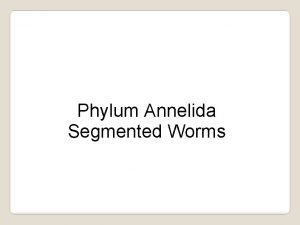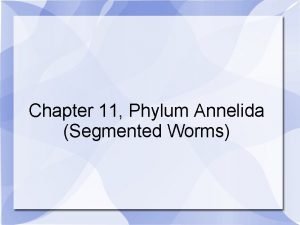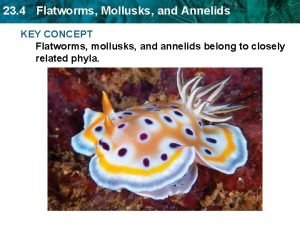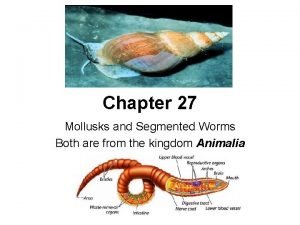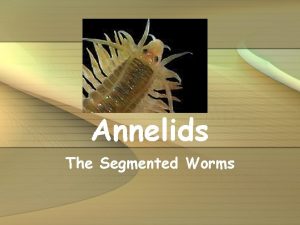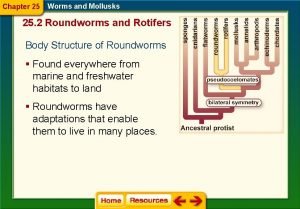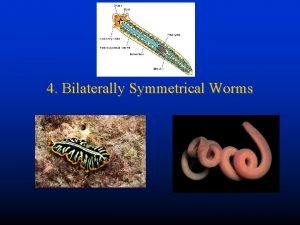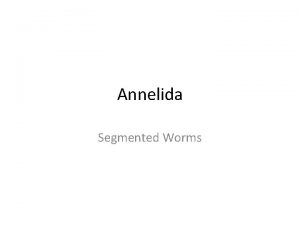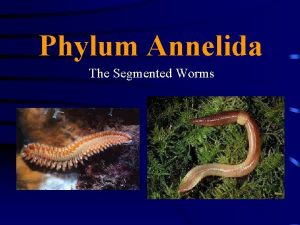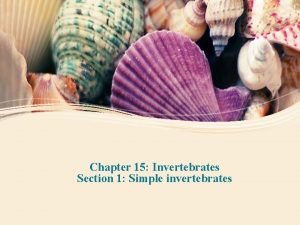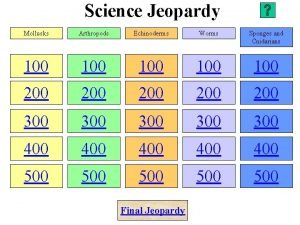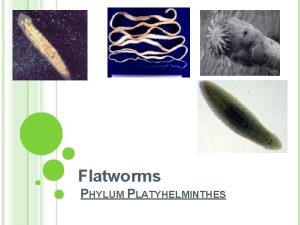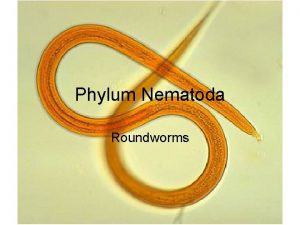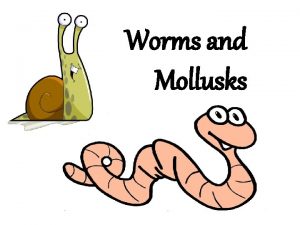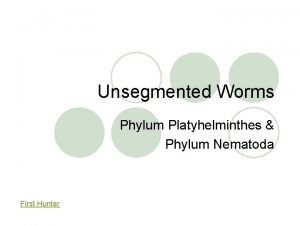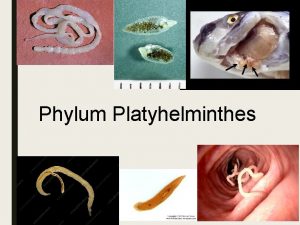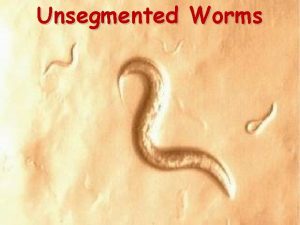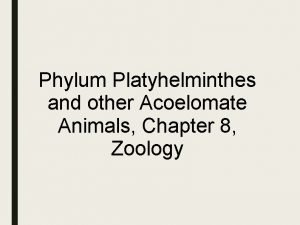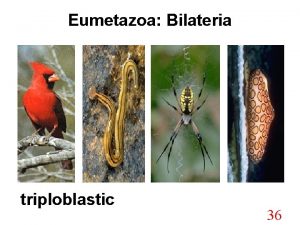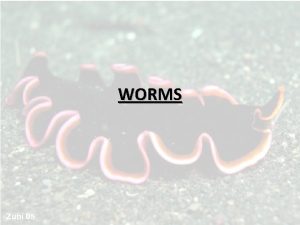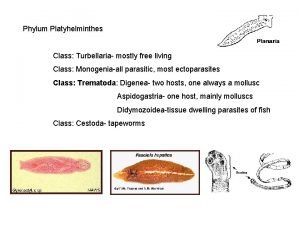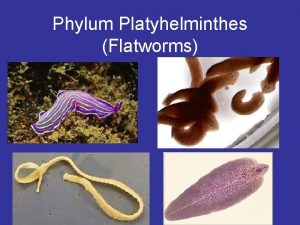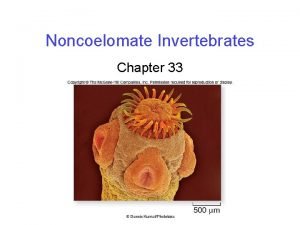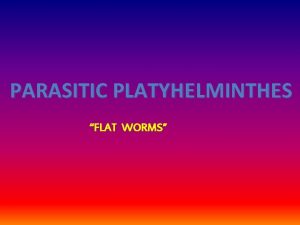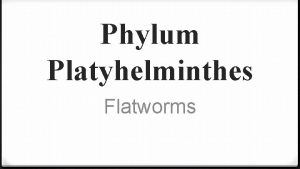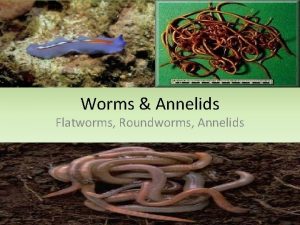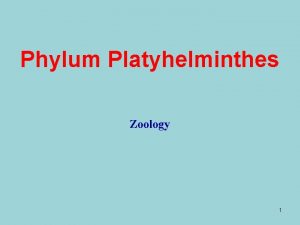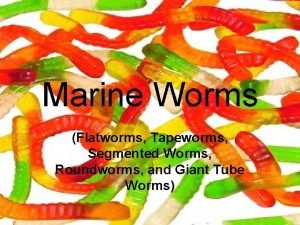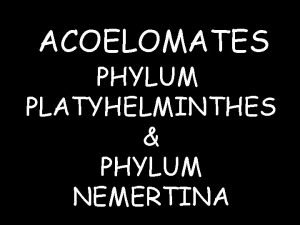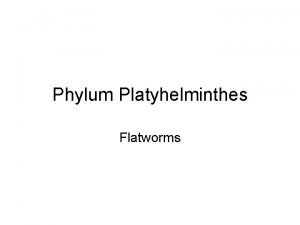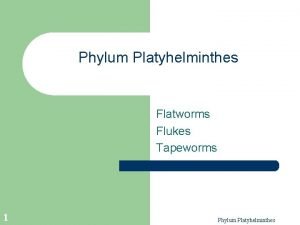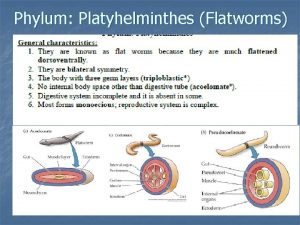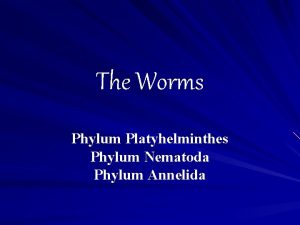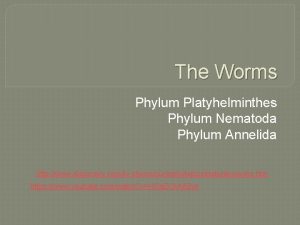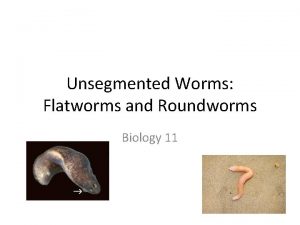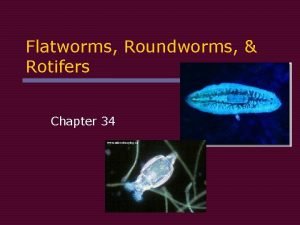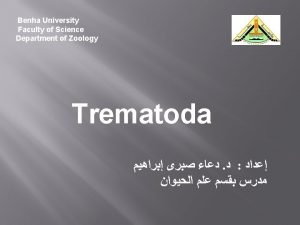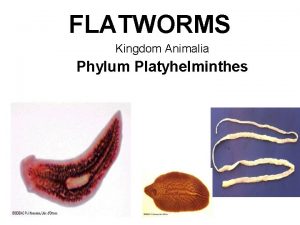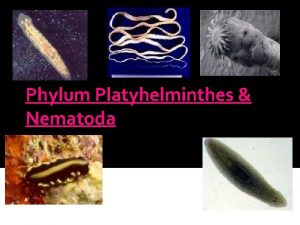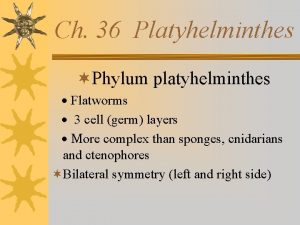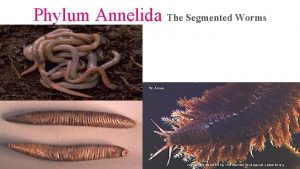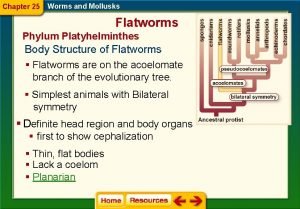Flatworms Roundworms Segmented Worms Phylum Platyhelminthes Flatworms Flat




























- Slides: 28

Flatworms, Roundworms, & Segmented Worms

Phylum Platyhelminthes • • Flatworms Flat and thin bodies Bilateral symmetry Most are parasitic

Phylum Platyhelminthes • Flatworms include planarians, flukes, and tapeworms • 20, 000 species of flatworms

Miscellaneous Information- Flatworms • Movement- use of moving bodies of water or damp soil, or larger animals transporting them • Nutrition- parasitic; the flatworm will take in food through same opening it eliminates waste • Circulatory system- Gastrovascular cavity with one opening • Digestion and excretion occur through same opening • Reproduction- flatworm splits in two forming a new flatworm

Tapeworms Information • Can get tapeworm infection by ingestion of food or water contaminated with tapeworm eggs or larvae • Can cause intestinal infections • Symptoms- poor appetite, diarrhea, weakness, gastrointestinal discomfort

Phylum Nematoda • Roundworms • Ex. Pinworms and hookworms • 90, 000 species of nematodes • Bilateral Symmetry • Live in wet soil or water • Eat dead leaves and other materials • Some eat insects that destroy plant roots • Some destroy plant roots

Flatworm Head • Head holds attachment hooks for host attachment • 2 eyespots to help detect light • Also contains brain called 2 simple brains called ganglia- simple bundles of nerves

Phylum Nematoda • Some roundworms can live in humans and make them sick • Roundworms have a complete digestive tract with 2 openings

Nervous System of Roundworms • Two nerve cords that transmit impulses in the roundworm

Miscellaneous Information. Roundworms • Reproduction- sexually, eggs deposited in soil after fertilization • Bilateral symmetry • No formal respiration, circulation, skeletal systems

Phylum Nematoda

Phylum Annelida • Annelids are segmented worms • Bodies are divided into many sections or segments • Live in moist soil, freshwater, or saltwater • 15, 000+ species of annelids • Examples: earthworms and leeches

Phylum Annelida • Earthworms – Have bristlelike Setae on each segment- helps in movement – Tunnel through soil to eat small pieces of food – Tunnels will loosen the soil and allow air to enter which helps plants to grow

Leeches and Us • Used in medicinal treatment • Abscesses, painful joints, glaucoma, myasthenia, and to heal venous diseases and thrombosis

Phylum Annelida

Miscellaneous Information. Segmented Worms • Nervous system- ganglia nerve centers in each segment that are connected by nerve cords to brain • Closed circulatory system- like humans • Gas exchange through skin- need for worm to live near water • Digestion- complete internal digestive tract that runs length of body – Gizzard- muscular sac and hard particles help grind soil and food before they pass into intestine Nephridia- collect/remove waste from each segment Pg. 731 is a good reference for earthworm body

Miscellaneous Information. Segmented Worms • Reproduction- Hermaphrodites • Produce both eggs and sperm

Phylum Annelida • Leeches – Eat small invertebrates – Can attach to skin of vertebrates and feed on its blood – Anesthetics in chemicals of bite to prevent pain – Leech secretes chemical so blood does not clot

Bilateral Symmetry and Body Plans • All bilaterally symmetrical animals developed from 3 embryonic cell layers: – Ectoderm – Endoderm – Mesoderm – 3 types- Acoelomates, Pseudocoelomates, Coelomates

Acoelomates • Develop from the 3 layers but have no body cavities • Digestive tract extends throughout body • May have been first group of animals to evolve • Ex. Flatworms

Acoelomates

Pseudocoelomates • Develop from the 3 layers • BUT also has a space that develops between the endoderm and mesoderm- called a pseudocoelom (difference between flatworm and roundworm)

Pseudocoelomates

Coelomates • Body cavities form from Coelom (fluid filled space that is completely surrounded by mesoderm where specialized organs and organ systems, serves to cushion and protect organs) • Humans, insects, fishes • Example: Earthworm • Greatest diversity among animals

Coelomates

Earthworm

Compare and Contrast • Flatworm and Earthworm digestive tracts • One opening to flatworm’s digestive tract (pharynx) • Earthworm’s digestive tract has 2 openings (mouth and anus)

3 types of worms Segmented Worms Roundworms Flatworms Phylum Annelida Phylum Nematoda Phylum Platyhelminthes Segmented/sectioned bodies, bilateral symmetry Bilateral symmetry, flat and thin bodies Moist soil, freshwater, or saltwater Wet soil or water Parasitic- live inside a host or in water Complete digestive tract- 2 openings (mouth and anus) Complete digestive tract with 2 openings (mouth and anus) One digestive opening (pharynx) Coelomate- form from coelom (fluid filled space surrounded by mesoderm) Pseudocoelomate- develop Acoelomate- develop from 3 layers, with space layers but have no body between endoderm and cavities mesoderm called Pseudocoelom Earthworms, leeches Pinworms, hookworms planarians, flukes and tapeworms
 Pseudocoelomate flatworm
Pseudocoelomate flatworm Segmented worm characteristics
Segmented worm characteristics Annelida characteristics
Annelida characteristics Reviewing key concepts: flatworms, annelids, and roundworms
Reviewing key concepts: flatworms, annelids, and roundworms Are worms mollusks
Are worms mollusks Characteristics of segmented worms
Characteristics of segmented worms Section 27-1 flatworms
Section 27-1 flatworms Chapter 25 section 2 roundworms and rotifers answers
Chapter 25 section 2 roundworms and rotifers answers Bilateral symmetry worm
Bilateral symmetry worm Acropora common name
Acropora common name Segmented worms characteristics
Segmented worms characteristics Marine flatworm symmetry
Marine flatworm symmetry What are some invertebrates
What are some invertebrates Chapter 27 mollusks and segmented worms answer key
Chapter 27 mollusks and segmented worms answer key Flatworms phylum
Flatworms phylum Threadworm egg
Threadworm egg Worm characteristics
Worm characteristics Unsegmented roundworms
Unsegmented roundworms Characteristics of platyhelminthes
Characteristics of platyhelminthes Belong worms
Belong worms Characteristics of platyhelminthes
Characteristics of platyhelminthes Nematódeos
Nematódeos Eumetazoa
Eumetazoa Phylum platyhelminthes examples
Phylum platyhelminthes examples Phylum platyhelminthes characteristics
Phylum platyhelminthes characteristics Phylum platyhelminthes characteristics
Phylum platyhelminthes characteristics Monogenia
Monogenia Symmetry of platyhelminthes
Symmetry of platyhelminthes Phylogeny of invertebrates
Phylogeny of invertebrates
